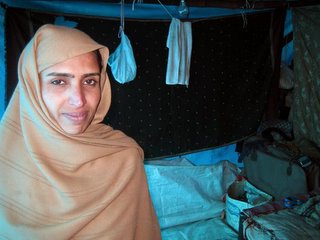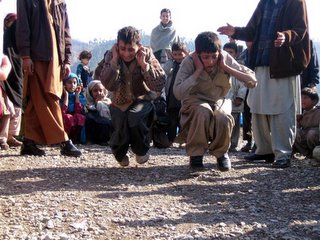 Day 9: BUILD BACK BETTER ... AN OPPORTUNITY TO HELP!
Day 9: BUILD BACK BETTER ... AN OPPORTUNITY TO HELP!Posted from Pakistan on Friday, Jan. 27, 2006
By Katie Roland, Metro Marketing &
Well, we are back in Islamabad now, wrapping up our trip. As I sit here in my hotel room, processing the experiences of the past week or so, I am both overwhelmed by all the devastation and destruction I have seen, and am hopeful for the recovery of this beautiful country. Continued below.

Children are safe at one of World Vision's "Child Friendly Spaces."


Pakistani men working to rebuild their earthquake-devastated community.

I have been welcomed by the people of Pakistan, in a place that typically has a good deal of apprehension toward Americans. I have met people who are eager to move on with their lives, who are picking up shovels, axes and hammers and are beginning to rebuild where they can.
I have met children who were once too scared to go to school and watched them join in games and singing at World Vision’s Child Friendly Spaces, places that enable them to overcome their fears and rebuild their self-confidence. I have met World Vision field staff who are deeply committed to seeing Pakistan restored and who are humbly and compassionately caring for children and their families.
I have seen amazing partnership between World Vision, the Pakistan Army and other nongovernmental organizations, and know that this rebuilding process is being done with a high level of integrity and a good deal of strategic planning.
And most importantly, I have had the opportunity to get to know some of the people who have been impacted by this quake, to learn their names, to hear their stories first-hand, and to grieve alongside them.
A reporter I spoke with this week asked me how I was handling the suffering I had witnessed. What a difficult question to answer, especially because some aspects of suffering can’t fully be explained. But the one thing I was able to share in my interview is that suffering provides an opportunity for those of us who can help to get involved. It enables people to bring healing and hope to those who might not be able to find it on their own.
As the world helps Pakistanis begin to rebuild their country, a common saying has emerged to frame the rebuilding process: “Build back better.” Though we may or may not know the kind of suffering so many Pakistanis are experiencing, we have an opportunity before us. We have the opportunity to participate in God’s plan for healing in a place that has been shaken. We have the option to pray, to hope, to give in ways that we’ve never done before. And we have the ability to help those in deep need to rebuild their communities better than they were before.
“For the mountains may depart and the hills be removed,
but my steadfast love shall not depart from you,
and my covenant of peace shall not be removed,”
says the Lord, who has compassion on you.
O afflicted one, storm-tossed and not comforted,
Behold, I will set your stones in antimony,
and lay your foundations with sapphires.
I will make your pinnacles of agate
your gates of carbuncles,
and all your wall of precious stones.
All your children shall be taught by the Lord,
and great shall be the peace of your children.
In righteousness you shall be established;
You shall be far from oppression, for you shall not fear;
and from terror, for it shall not come near you.

























